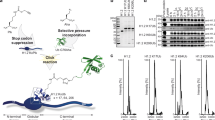Abstract
We have developed a readily accessible disulfide-directed methodology for the site-specific modification of histones by ubiquitin and ubiquitin-like proteins. The disulfide-linked analog of mono-ubiquitylated H2B stimulated the H3K79 methyltransferase activity of hDot1L to a similar extent as the native isopeptide linkage. This permitted structure-activity studies of ubiquitylated mononucleosomes that revealed plasticity in the mechanism of hDot1L stimulation and identified surfaces of ubiquitin important for activation.

Similar content being viewed by others
References
Hershko, A. & Ciechanover, A. Annu. Rev. Biochem. 67, 425–479 (1998).
Deshaies, R.J. & Joazeiro, C.A.P. Annu. Rev. Biochem. 78, 399–434 (2009).
Goldknopf, I.L. & Busch, H. Proc. Natl. Acad. Sci. USA 74, 864–868 (1977).
West, M.H. & Bonner, W.M. Nucleic Acids Res. 8, 4671–4680 (1980).
Nickel, B.E., Allis, C.D. & Davie, J.R. Biochemistry 28, 958–963 (1989).
Shilatifard, A. Annu. Rev. Biochem. 75, 243–269 (2006).
Jenuwein, T. & Allis, C.D. Science 293, 1074–1080 (2001).
Weake, V.M. & Workman, J.L. Mol. Cell 29, 653–663 (2008).
Kim, J. et al. Cell 137, 459–471 (2009).
McGinty, R., Kim, J., Chatterjee, C., Roeder, R. & Muir, T. Nature 453, 812–816 (2008).
Okada, Y. et al. Cell 121, 167–178 (2005).
Zhu, B. et al. Mol. Cell 20, 601–611 (2005).
Chatterjee, C., McGinty, R.K., Pellois, J.P. & Muir, T.W. Angew. Chem. Int. Edn Engl. 46, 2814–2818 (2007).
Van Kasteren, S.I. et al. Nature 446, 1105–1109 (2007).
Simon, M. et al. Cell 128, 1003–1012 (2007).
Luger, K., Mader, A.W., Richmond, R.K., Sargent, D.F. & Richmond, T.J. Nature 389, 251–260 (1997).
Rabanal, F., DeGrado, W. & Dutton, P. Tetrahedr. Lett. 37, 1347–1350 (1996).
Minsky, N. & Oren, M. Mol. Cell 16, 631–639 (2004).
Geng, F. & Tansey, W.P. Mol. Biol. Cell 19, 3616–3624 (2008).
McGinty, R.K. et al. ACS Chem. Biol. 4, 958–968 (2009).
Whitby, F.G., Xia, G., Pickart, C.M. & Hill, C.P. J. Biol. Chem. 273, 34983–34991 (1998).
Ramelot, T.A. et al. J. Struct. Funct. Genomics 4, 25–30 (2003).
Hicke, L. Nat. Rev. Mol. Cell Biol. 2, 195–201 (2001).
Acknowledgements
We acknowledge J. Fernandez, L. Miller and R. Angeletti for assistance with ESI-MS analysis. We thank J. Kim and R. Subramanian for help in preparing hDot1 and M. Pratt for stimulating discussions. This work was funded by the US National Institutes of Health (grant number RC2CA148354) and the Starr Cancer Consortium. B.F. was supported by the Novartis and Swiss National Science Foundations. R.K.M. was supported by a US National Institutes of Health Medical Scientist Training Program grant.
Author information
Authors and Affiliations
Contributions
C.C. and T.W.M. designed the experiments. C.C. performed the experiments. C.C., R.K.M. and B.F. prepared new reagents. C.C. and T.W.M. analyzed the experimental results and wrote the manuscript.
Corresponding author
Ethics declarations
Competing interests
The authors declare no competing financial interests.
Supplementary information
Supplementary Text and Figures
Supplementary Methods and Supplementary Figures 1–18 (PDF 5450 kb)
Rights and permissions
About this article
Cite this article
Chatterjee, C., McGinty, R., Fierz, B. et al. Disulfide-directed histone ubiquitylation reveals plasticity in hDot1L activation. Nat Chem Biol 6, 267–269 (2010). https://doi.org/10.1038/nchembio.315
Received:
Accepted:
Published:
Issue Date:
DOI: https://doi.org/10.1038/nchembio.315
- Springer Nature America, Inc.
This article is cited by
-
Recent advances in chemical protein synthesis: method developments and biological applications
Science China Chemistry (2024)
-
The dynamics and functional mechanisms of H2B mono-ubiquitination
Crop Health (2024)
-
Site-specific ubiquitylation acts as a regulator of linker histone H1
Nature Communications (2021)
-
The Bre1/Rad6 machinery: writing the central histone ubiquitin mark on H2B and beyond
Chromosome Research (2020)
-
Nucleosome and ubiquitin position Set2 to methylate H3K36
Nature Communications (2019)





